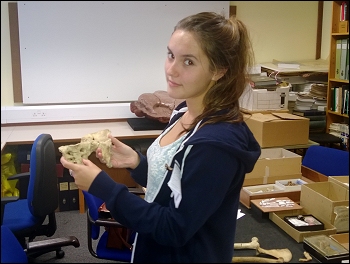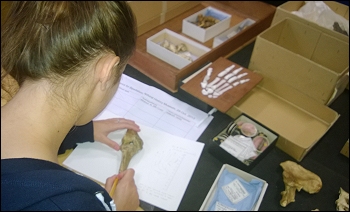A Burnham-On-Sea student is carrying out research at the Natural History Museum in London as part of a study on human ancestors.
Katie Chedzey of Year 13 at Highbridge’s King Alfred School was invited into the research laboratories of the Natural History Museum in Kensington as part of her work towards completing an Extended Project Qualification.
She is studying the origins of hominin bipedalism – upright walking in our human ancestors – so she was thrilled to have the opportunity of analysing some of the priceless fossil specimens held in the vaults of the Palaeontology Department.
“A particular highlight for Katie was the analysis of the famous ‘Lucy’ skeleton that dates to 3.2 million-years-ago and belongs to the species Australopithecus afarensis,” said a school spokesman.
 “Katie was able to determine that ‘Lucy’ was able to walk fully upright due to the human-like pelvis and femur, even though she retained many ape-like features such as a small, chimpanzee-size brain and longer arms.”
“Katie was able to determine that ‘Lucy’ was able to walk fully upright due to the human-like pelvis and femur, even though she retained many ape-like features such as a small, chimpanzee-size brain and longer arms.”
“Katie was then able to compare the rather diminutive ‘Lucy’, standing at 1.1m high, with the 1.7 million-year-old Homo erectus skeleton belonging to the so-
called ‘Nariokotome Boy’ who already stood at 1.6m tall when he died at the age of 11 years.”
“Working with these fossils allowed Katie to conclude that human bipedalism goes back millions of years but only in the last two million years do we see the evolution of endurance running and more human-like body proportions.”
Pictured: Katie at work the Natural History Museum in London (photos submitted)







